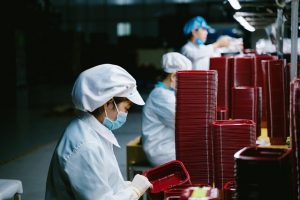激動の世界経済、注目の中国経済その変化を点描!中国食品加工業界:変化の最前線を見守った現場のリアル
 イメージ
イメージ
激動の世界経済、注目の中国経済その変化を点描!
中国食品加工業界この20年:変化の最前線を見守った現場のリアル
明けましておめでとうございます。
皆様のご健康とご多幸をお祈り申し上げます。
さて、新年を迎えても私たちの周辺では、食品を含め物価の高騰が続いています。
肌感覚ですが、近くのスーパーマーケットでも、昨年1年間でお昼のお弁当が
約30%上昇した感じです。
また、唐突ですが、お隣の中国の経済状況はさらに厳しい様です。
昨年発表された、経済成長率: 2024年1月から9月の中国の実質GDP成長率は4.8%で、
政府目標の5%にやや届かない状況です。
目標達成に向け、政府は金融緩和や財政刺激策を矢継ぎ早に導入していますが、
依然として不動産市場の低迷が足かせとなっています
こうした中で、近未来はどうなるのか?
日本国内に住む私たちの生活に深く関わる食品について専門家に
お聞きしました。
 イメージ
イメージ
中国食品業界に深く携わり、最前線で変化を見続けてきた小西さん(仮名)に
再度インタビューをお願いしました。
「一言で言えば、中国はハングリーです」と語るその言葉には、
急速な進化を遂げる中国食品加工業界への驚きと、
そのスピードに追いつく挑戦の日々が垣間見えます。
この記事では、加工工場の変化、マーケットの移り変わり、
そして現場でのリアルな課題と展望を詳しく掘り下げます。
インタビュー:小西さん(食品業界のベテラン)
Q1:中国の加工工場の20年を振り返ると?
「私たちが中国に進出し始めた20年前、加工工場は日本市場向けの基準を
クリアするため、最低限の設備は整っていました。
ただし、現場では人海戦術が中心でした。白身フライの例を挙げると、
以下の流れです。
- 魚の下処理
鱗を取り、骨を抜き、開きにする。これらすべてが手作業。
日本の衛生基準を満たすように細心の注意が払われました。
- パン粉付け
開いた魚に手作業でパン粉をまぶし、整える作業を数百人規模で実施。
冷凍前の加工が従業員の手で次々と行われました。
当時、工場は体育館のような建物で、テーブルが何列にも並び、
従業員が両側に立って作業する形式でした。
ただ、急速冷凍機は導入済みで、冷凍技術はすでに
日本と同水準。これは大きな強みでした。
さらに、工場敷地内には従業員寮も完備され、24時間交代制で稼働。
数百人規模の女性従業員が暮らしながら働いていました。」
その操業体制は「壮観」の一言ですね。
今もハッキリ覚えています。
具体的にはお話できませんが、こうした体制なので、
商品もかなり安価に仕入れる事が可能でした。
 イメージ
イメージ
Q2:20年で加工工場はどう進化したのですか?
「工場は急速に近代化しました。手作業中心だった工程の多くが機械化され、
衛生管理の基準も向上しています。
具体的には以下の変化があります。
〇設備の進化
例えば、魚の鱗取りや骨抜き、パン粉付けの工程は、現在では機械が主体。
これにより生産効率が飛躍的に向上しました。
〇従業員の変化
人手に依存する部分は減ったものの、高度な機械操作や品質管理を
担当する従業員が必要となり、現場のスキル水準も向上しました。
〇環境の変化
工場そのものが、広い敷地に専用の生産ラインや管理棟を備えた本格的な施設へと進化しました。
以上の様に加工現場(生産体制、工場機能)は本当に大きく変わってきました。
食品業界のベテランが見た 中国の変遷のリアル 次回に続く!
 image
image
The Turbulent Global Economy and the Changing Chinese Economy: A Snapshot
China’s Food Processing Industry Over the Past 20 Years:
The Realities Witnessed on the Frontlines
As we welcome the new year,
I wish you all health and happiness.
Even with the new year upon us,
inflation continues to affect our daily lives,
including food prices.
Speaking from personal experience,
the price of lunch boxes at nearby supermarkets seems to
have risen by about 30% over the past year.
Meanwhile, China’s economic situation appears even more challenging.
According to last year’s data,
China’s real GDP growth rate from January to September 2024 was 4.8%,
slightly below the government’s target of 5%.
To achieve this target,
the government has rapidly introduced measures such as monetary easing and fiscal stimulus,
yet the sluggish real estate market remains a significant obstacle.
Amid these challenges, we spoke to an expert about food,
a topic that deeply impacts the daily lives of those of us living in Japan.
We once again interviewed Mr. Konishi (pseudonym),
who has been deeply involved in China’s food industry and
has closely observed changes on the frontlines.
 image
image
“In a word, China is hungry,” he said.
His words reflect both astonishment at the rapid evolution of China’s
food processing industry and
the daily challenges of keeping up with its speed.
This article delves into the changes in processing plants,
shifts in the market, and the real challenges and
prospects seen on the ground.
Interview: Mr. Konishi (Veteran in the Food Industry)
Q1: Looking back on 20 years of processing plants in China,
what stands out?
“Twenty years ago, when we began expanding into China,
the processing plants had just enough equipment to meet the standards of
the Japanese market.
However, manual labor was the mainstay at the time.
For example, let’s look at whitefish fillet production:
Pre-processing the fish
Removing scales, deboning, and filleting—all done by hand.
Extreme care was taken to meet Japanese hygiene standards.
Breadcrumbing
Breadcrumbs were applied and shaped manually,
with hundreds of workers handling this process.
All pre-freezing steps were carried out by hand.
At that time,
the factories resembled gymnasiums with rows of tables,
and workers stood on both sides to perform tasks.
That said, rapid freezing equipment,
already on par with Japanese standards,
was in place, which was a significant strength.
Additionally, employee dormitories were set up within the factory premises,
and operations were run 24 hours a day in shifts.
Hundreds of female employees lived and worked there.
The scale of operations was truly ‘spectacular.’
I still remember it vividly.
While I can’t disclose specific figures,
this system allowed us to procure products at very low costs.”
 image
image
Q2: How have processing plants evolved over
the past 20 years?
“The factories have undergone rapid modernization.
Many processes that once relied on manual labor are now mechanized,
and hygiene management standards have also improved.
Here are some of the notable changes:
Equipment Evolution
Processes such as descaling, deboning,
and breadcrumbing are now primarily handled by machines,
leading to a dramatic increase in production efficiency.
Changes in Workforce
While dependency on manual labor has decreased,
the need for skilled workers to operate advanced machinery and
oversee quality control has increased,
raising the skill level of workers on-site.
Facility Upgrades
Factories have transformed into full-scale facilities with
dedicated production lines and management buildings on expansive sites.”
In summary,
the production systems and factory functions have changed significantly.
Veteran Insights into China’s Evolution in the Food Industry:
Stay Tuned for Part 2!

